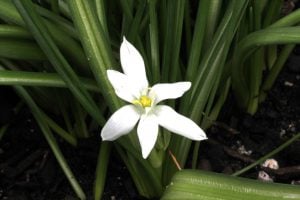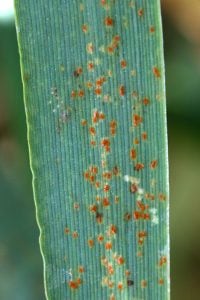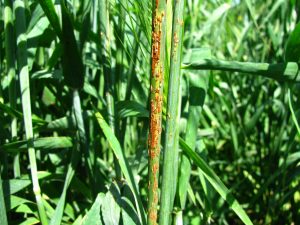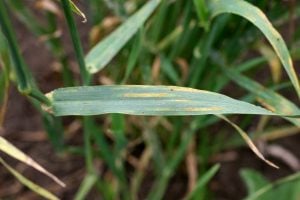There are five different rusts that can infect barley. Each varies in importance depending on variety susceptivity, seasonal conditions and control strategies in place.
- Leaf rust, caused by Puccinia hordei, is common in high rainfall areas and is present in other areas during wet seasons. Losses of up to 20% are possible during favourable seasons.
- Stem rust, caused by Puccinia graminis, is uncommon but can cause severe crop losses of up to 40% during wet and warm seasons.
- Barley grass stripe rust, Puccinia striiformis sp. pseudo- hordei, is very common on barley grass and can infect some susceptible varieties. However it generally does not cause loss.
- Wheat stripe rust, Puccinia striiformis sp. tritici can infect barley and is generally observed with low severity.
- Barley stripe rust, caused by Puccinia striiformis sp. hordei is an exotic disease that can potentially cause severe infection and losses of up to 30%.
Leaf rust occurs most years in susceptible varieties, especially in high rainfall regions. Early infections (July – August) can result in yield losses of up to 20 per cent. Stem rust is potentially the most devastating disease of the rusts and is able to cause complete crop loss in the rare event where conditions are suitable for a severe outbreak. Barley grass stripe rust is common but unlikely to cause yield loss. The exotic pathogen barley stripe rust will cause severe losses of up to 30 per cent in most varieties if it is introduced to Australia.
Rust Disease Cycle
(See Wheat Rust Life Cycles)
The primary source of inoculum for leaf rust is volunteer barley plants that survive over summer. Development of leaf rust is most rapid during warm (15-20°C), moist (rain or dew) weather. Crops that have a late maturity, following a wet summer are often more severely infected.
The ‘Star of Bethlehem’ (Ornithogalum umbellatum) weed can be a source of inoculum and is a host for the alternate, sexual stage of teleospores. The sexual cycle results in new strains that can overcome resistances. Currently the Star of Bethlehem weed occurs in South Australia with isolated occurrences through the Victorian cropping zone.
Leaf Rust: What to Look For
Pustules of leaf rust are small and circular producing a mass of orange-brown powdery spores predominantly on the upper leaf surfaces.
These pustules easily rub off on a finger. Later in the season, pustules also develop on leaf sheaths. As the crop matures the pustules turn dark and produce black spores embedded in the old plant tissues. Leaf and stem rust may be confused but are distinguished by their colour and size, leaf rust being lighter coloured, smaller and rounder than stem rust.
Stem Rust: What to Look For
Pustules are large, oval to elongated and are often surrounded by a characteristic torn margin. The pustules are full of reddish, brown spores which fall away easily. They can occur on stems, leaf surfaces, the leaf sheaths and heads. As a plant matures, the pustules produce black spores that do not dislodge.
Barley Grass Stripe Rust: What to Look For
Symptoms are very similar to stripe rust in wheat. Bright yellow-orange spores form pustules that occur in stripes along the leaves.
In young leaves, the pustules tend to be scattered across the leaf. Spores rub off easily onto a finger. Barley grass stripe rust and barley stripe rust have the same symptoms. Unusually severe reactions could indicate the exotic barley stripe rust and must be reported via the Exotic Plant Pest Hotline (1800 084 881).
Management of Rusts
Resistant Varieties
The most effective way to control rusts of barley is to grow varieties with resistance, which:
- reduce the amount of disease in a crop and neighbouring crops
- reduce the need for fungicide application
It is important to note that new races of barley rust can develop that overcome varieties with resistance. To select varieties with effective resistance, it is essential to consult a current Victorian Cereal Disease Guide or the NVT website.
Cultural Practices
These rusts survive predominantly on summer/autumn volunteers which provide significant inoculum loads if left unmanaged. Removing the inoculum provided by self-sown barley is very effective in reducing risk of loss. Use grazing and/or herbicides to remove green growth, especially during wet summers and aim to eliminate the green bridge prior to March for greatest benefit.
Seed Treatment
Fluxapyroxad is registered for control of barley leaf rust which can prevent early leaf rust infection. Efficacy is likely to vary between seasons and a follow up foliar fungicide application may be necessary for control later in the season.
Fungicides
There is a range of foliar applied fungicides available that will give disease suppression of leaf rust in barley. Research by Agriculture Victoria and Birchip Cropping Group has shown that the most effective suppression of leaf rust was achieved when foliar fungicides were applied early in an epidemic. Additional applications may also be required where rust pressure is sustained during a wet spring.
Seed applied fluxapyroxad and fertilizer applied fungicides are registered for control of barley leaf rust. These can prevent early leaf rust infection, however, efficacy is likely to reduce significantly as the season progresses. Continue to monitor crops during the season as a follow up application of foliar fungicide may be necessary if the epidemic persists during the spring months.
Please note: This book is also available on AppleBooks






